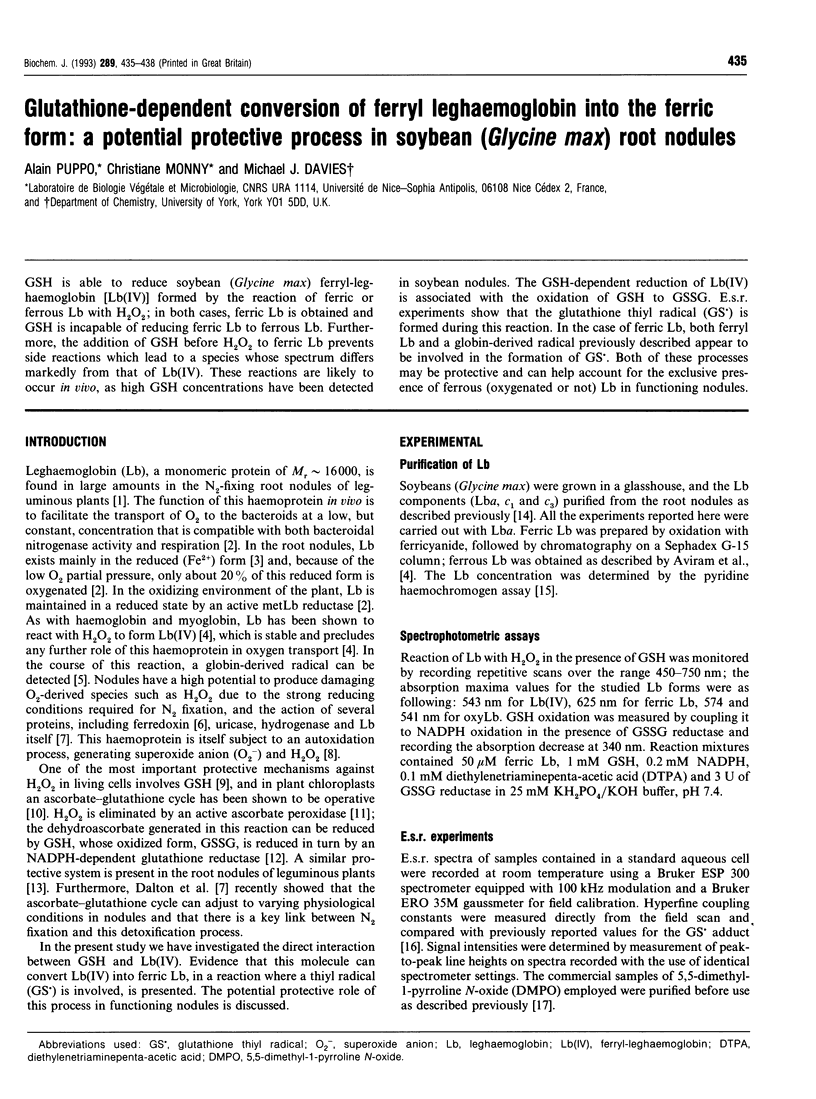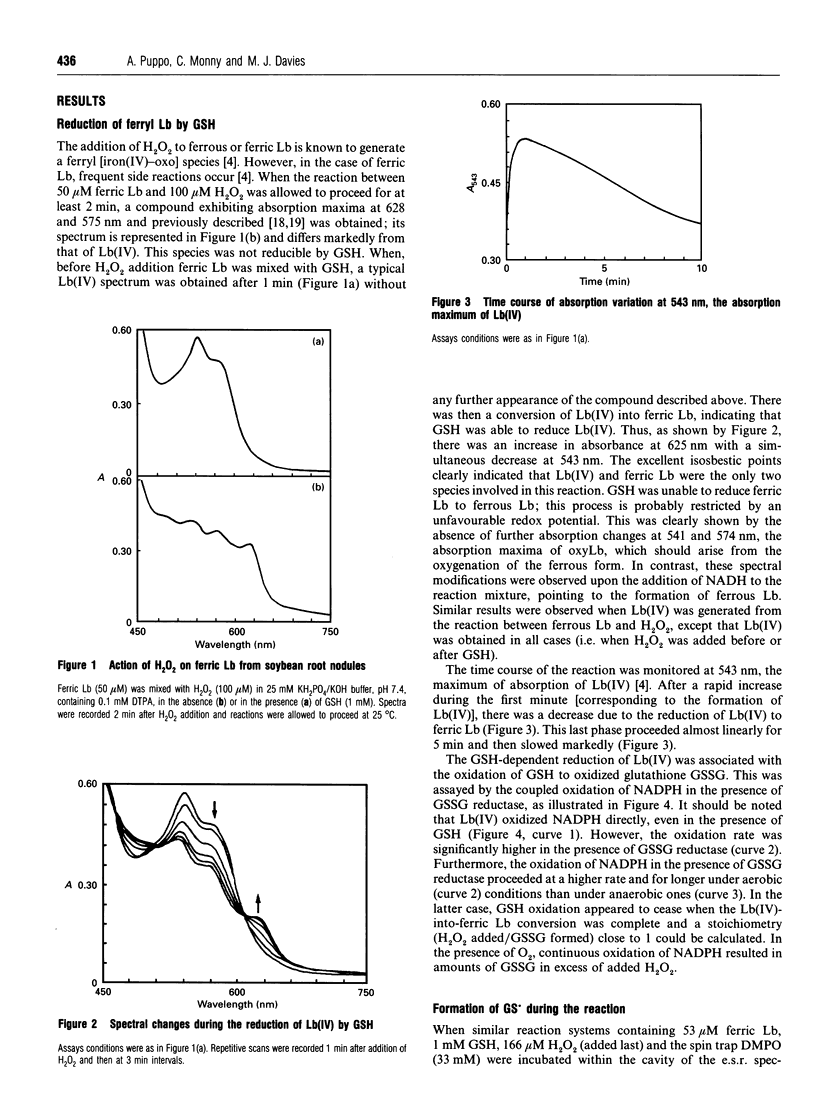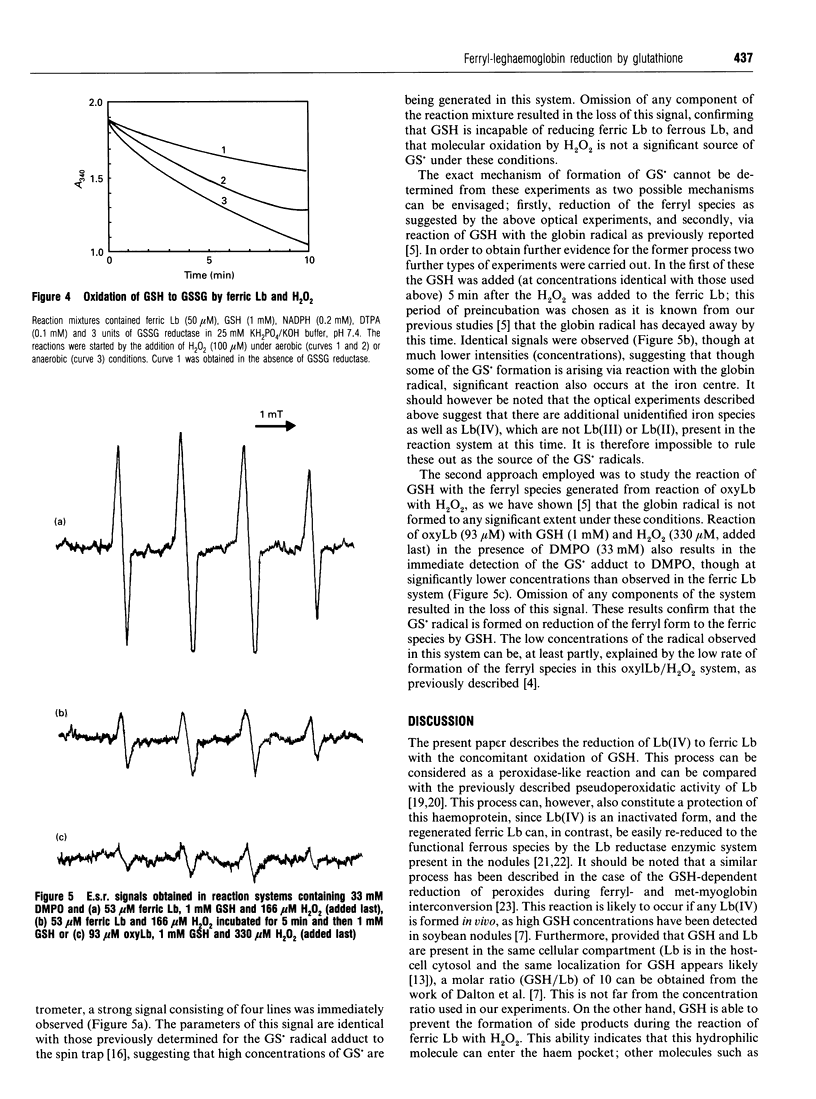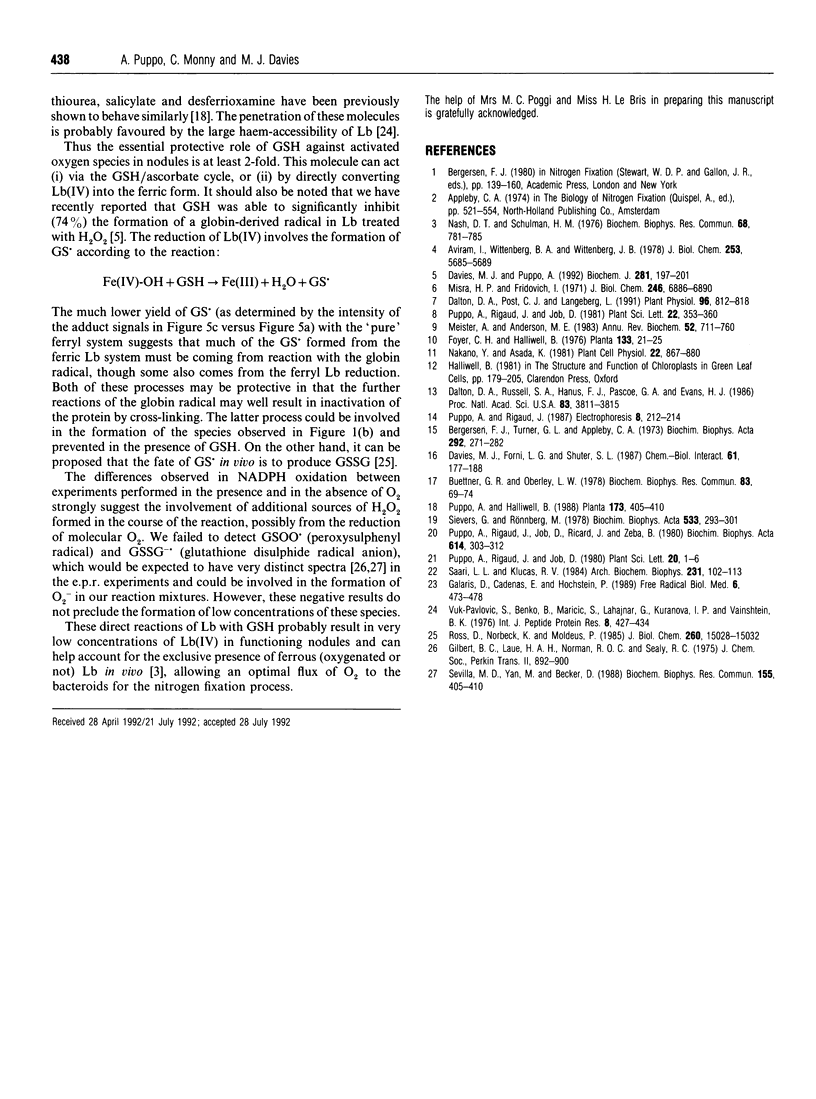Abstract
GSH is able to reduce soybean (Glycine max) ferryl-leghaemoglobin [Lb(IV)] formed by the reaction of ferric or ferrous Lb with H2O2; in both cases, ferric Lb is obtained and GSH is incapable of reducing ferric Lb to ferrous Lb. Furthermore, the addition of GSH before H2O2 to ferric Lb prevents side reactions which lead to a species whose spectrum differs markedly from that of Lb(IV). These reactions are likely to occur in vivo, as high GSH concentrations have been detected in soybean nodules. The GSH-dependent reduction of Lb(IV) is associated with the oxidation of GSH to GSSG. E.s.r. experiments show that the glutathione thiyl radical (GS.) is formed during this reaction. In the case of ferric Lb, both ferryl Lb and a globin-derived radical previously described appear to be involved in the formation of GS.. Both of these processes may be protective and can help account for the exclusive presence of ferrous (oxygenated or not) Lb in functioning nodules.
Full text
PDF



Selected References
These references are in PubMed. This may not be the complete list of references from this article.
- Aviram I., Wittenberg A., Wittenberg J. B. The reaction of ferrous leghemoglobin with hydrogen peroxide to form leghemoglobin(IV). J Biol Chem. 1978 Aug 25;253(16):5685–5689. [PubMed] [Google Scholar]
- Bergersen F. J., Turner G. L., Appleby C. A. Studies of the physiological role of leghaemoglobin in soybean root nodules. Biochim Biophys Acta. 1973 Jan 18;292(1):271–282. doi: 10.1016/0005-2728(73)90271-5. [DOI] [PubMed] [Google Scholar]
- Buettner G. R., Oberley L. W. Considerations in the spin trapping of superoxide and hydroxyl radical in aqueous systems using 5,5-dimethyl-1-pyrroline-1-oxide. Biochem Biophys Res Commun. 1978 Jul 14;83(1):69–74. doi: 10.1016/0006-291x(78)90398-4. [DOI] [PubMed] [Google Scholar]
- Dalton D. A., Post C. J., Langeberg L. Effects of ambient oxygen and of fixed nitrogen on concentrations of glutathione, ascrobate, and associated enzymes in soybean root nodules. Plant Physiol. 1991 Jul;96(3):812–818. doi: 10.1104/pp.96.3.812. [DOI] [PMC free article] [PubMed] [Google Scholar]
- Dalton D. A., Russell S. A., Hanus F. J., Pascoe G. A., Evans H. J. Enzymatic reactions of ascorbate and glutathione that prevent peroxide damage in soybean root nodules. Proc Natl Acad Sci U S A. 1986 Jun;83(11):3811–3815. doi: 10.1073/pnas.83.11.3811. [DOI] [PMC free article] [PubMed] [Google Scholar]
- Davies M. J., Puppo A. Direct detection of a globin-derived radical in leghaemoglobin treated with peroxides. Biochem J. 1992 Jan 1;281(Pt 1):197–201. doi: 10.1042/bj2810197. [DOI] [PMC free article] [PubMed] [Google Scholar]
- Galaris D., Cadenas E., Hochstein P. Glutathione-dependent reduction of peroxides during ferryl- and met-myoglobin interconversion: a potential protective mechanism in muscle. Free Radic Biol Med. 1989;6(5):473–478. doi: 10.1016/0891-5849(89)90039-7. [DOI] [PubMed] [Google Scholar]
- Meister A., Anderson M. E. Glutathione. Annu Rev Biochem. 1983;52:711–760. doi: 10.1146/annurev.bi.52.070183.003431. [DOI] [PubMed] [Google Scholar]
- Misra H. P., Fridovich I. The generation of superoixide radical during the autoxidation of ferredoxins. J Biol Chem. 1971 Nov 25;246(22):6886–6890. [PubMed] [Google Scholar]
- Nash D. T., Schulman H. M. The absence of oxidized leghemoglobin in soybean root nodules during nodule development. Biochem Biophys Res Commun. 1976 Feb 9;68(3):781–785. doi: 10.1016/0006-291x(76)91213-4. [DOI] [PubMed] [Google Scholar]
- Puppo A., Rigaud J., Job D., Ricard J., Zeba B. Peroxidase content of soybean root nodules. Biochim Biophys Acta. 1980 Aug 7;614(2):303–312. doi: 10.1016/0005-2744(80)90220-x. [DOI] [PubMed] [Google Scholar]
- Ross D., Norbeck K., Moldéus P. The generation and subsequent fate of glutathionyl radicals in biological systems. J Biol Chem. 1985 Dec 5;260(28):15028–15032. [PubMed] [Google Scholar]
- Saari L. L., Klucas R. V. Ferric leghemoglobin reductase from soybean root nodules. Arch Biochem Biophys. 1984 May 15;231(1):102–113. doi: 10.1016/0003-9861(84)90367-9. [DOI] [PubMed] [Google Scholar]
- Sevilla M. D., Yan M. Y., Becker D. Thiol peroxyl radical formation from the reaction of cysteine thiyl radical with molecular oxygen: an ESR investigation. Biochem Biophys Res Commun. 1988 Aug 30;155(1):405–410. doi: 10.1016/s0006-291x(88)81100-8. [DOI] [PubMed] [Google Scholar]
- Sievers G., Rönnberg M. Study of the pseudoperoxidatic activity of soybean leghemoglobin and sperm whale myoglobin. Biochim Biophys Acta. 1978 Apr 26;533(2):293–301. doi: 10.1016/0005-2795(78)90376-8. [DOI] [PubMed] [Google Scholar]
- Vuk-pavlović S., Benko B., Maricić S., Lahajnar G., Kuranova I. P., Vainshtein B. K. The haem-accessibility in leghaemoglobin of Lupinus luteus as observed by proton magnetic relaxation. Int J Pept Protein Res. 1976;8(5):427–434. doi: 10.1111/j.1399-3011.1976.tb02522.x. [DOI] [PubMed] [Google Scholar]


